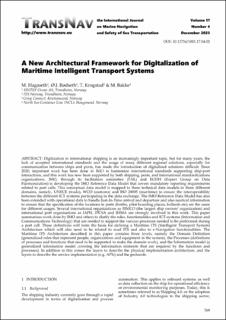| dc.contributor.author | Hagaseth, Marianne | |
| dc.contributor.author | Rødseth, Ørnulf Jan | |
| dc.contributor.author | Krogstad, T. | |
| dc.contributor.author | Bakke, Magnus | |
| dc.date.accessioned | 2023-11-22T08:59:54Z | |
| dc.date.available | 2023-11-22T08:59:54Z | |
| dc.date.created | 2023-11-16T14:32:44Z | |
| dc.date.issued | 2023 | |
| dc.identifier.issn | 2083-6473 | |
| dc.identifier.uri | https://hdl.handle.net/11250/3104014 | |
| dc.description | The Transnav - International Journal on Marine Navigation and Safety of Sea Transportation articles are distributed under the terms of the Creative Commons Attribution License (CC BY-NC), which permits unrestricted use, distribution, and reproduction in any medium, provided the original author and source are credited. For licence details please see http://creativecommons.org/licenses/by-nc/3.0/ | en_US |
| dc.description.abstract | Digitization in international shipping is an increasingly important topic, but for many years, the lack of accepted international standards and the usage of many different regional solutions, especially for communication between ships and ports, has made the introduction of digitalized solutions difficult. Since 2020, important work has been done in IMO to harmonize international standards supporting ship-port interactions, and this work has now been supported by both shipping, ports, and international standardizations organizations. IMO, through its facilitation committee (FAL) and EGDH (Expert Group on Data Harmonization) is developing the IMO Reference Data Model that covers mandatory reporting requirements related to port calls. This conceptual data model is mapped to three technical data models in three different domains, namely, UNECE (trade), WCO (customs) and ISO 28005 (maritime) to ensure the interoperability between the different ICT systems participating in the data exchange. The IMO Reference Data Model has also been extended with operational data to handle Just-In-Time arrival and departure and also nautical information to ensure that the specification of the locations in ports (berths, pilot boarding places, bollards etc) are the same for different usages. Several international organizations as BIMCO (the largest ship owners' organization) and international port organisations as IAPH, IPCSA and IHMA are strongly involved in this work. This paper summarizes work done by IMO and others to clarify the roles, functionalities and ICT-systems (Information and Communications Technology) that are needed to support the various processes needed to be performed during a port call. These definitions will form the basis for defining a Maritime ITS (Intelligent Transport System) Architecture which will also need to be related to road ITS and also to e-Navigation functionalities. The Maritime ITS Architecture described in this paper contains three levels, namely the Domain Definition (generalized roles that represent people, organizations and equipment in the system), the Processes (definitions of processes and functions that need to be supported to make the domain work), and the Information model (a generalized information model covering the information elements that are required by the functions and processes). In addition to this comes the layers to describe the physical implementation architecture, and the layers to describe the service implementation (e.g. APIs) and the protocols. | en_US |
| dc.language.iso | eng | en_US |
| dc.publisher | Faculty of Navigation, Gdynia Maritime University, Poland | en_US |
| dc.rights | Navngivelse-Ikkekommersiell 4.0 Internasjonal | * |
| dc.rights.uri | http://creativecommons.org/licenses/by-nc/4.0/deed.no | * |
| dc.subject | International shipping | en_US |
| dc.subject | Digital communication standards | en_US |
| dc.subject | Port calls | en_US |
| dc.subject | Maritime ITS | en_US |
| dc.title | A New Architectural Framework for Digitalization of Maritime Intelligent Transport Systems | en_US |
| dc.title.alternative | A New Architectural Framework for Digitalization of Maritime Intelligent Transport Systems | en_US |
| dc.type | Journal article | en_US |
| dc.type | Peer reviewed | en_US |
| dc.description.version | publishedVersion | en_US |
| dc.source.volume | 17 | en_US |
| dc.source.journal | TransNav, International Journal on Marine Navigation and Safety of Sea Transportation | en_US |
| dc.source.issue | 4 | en_US |
| dc.identifier.doi | 10.12716/1001.17.04.02 | |
| dc.identifier.cristin | 2197664 | |
| cristin.ispublished | true | |
| cristin.fulltext | original | |
| cristin.qualitycode | 1 | |

